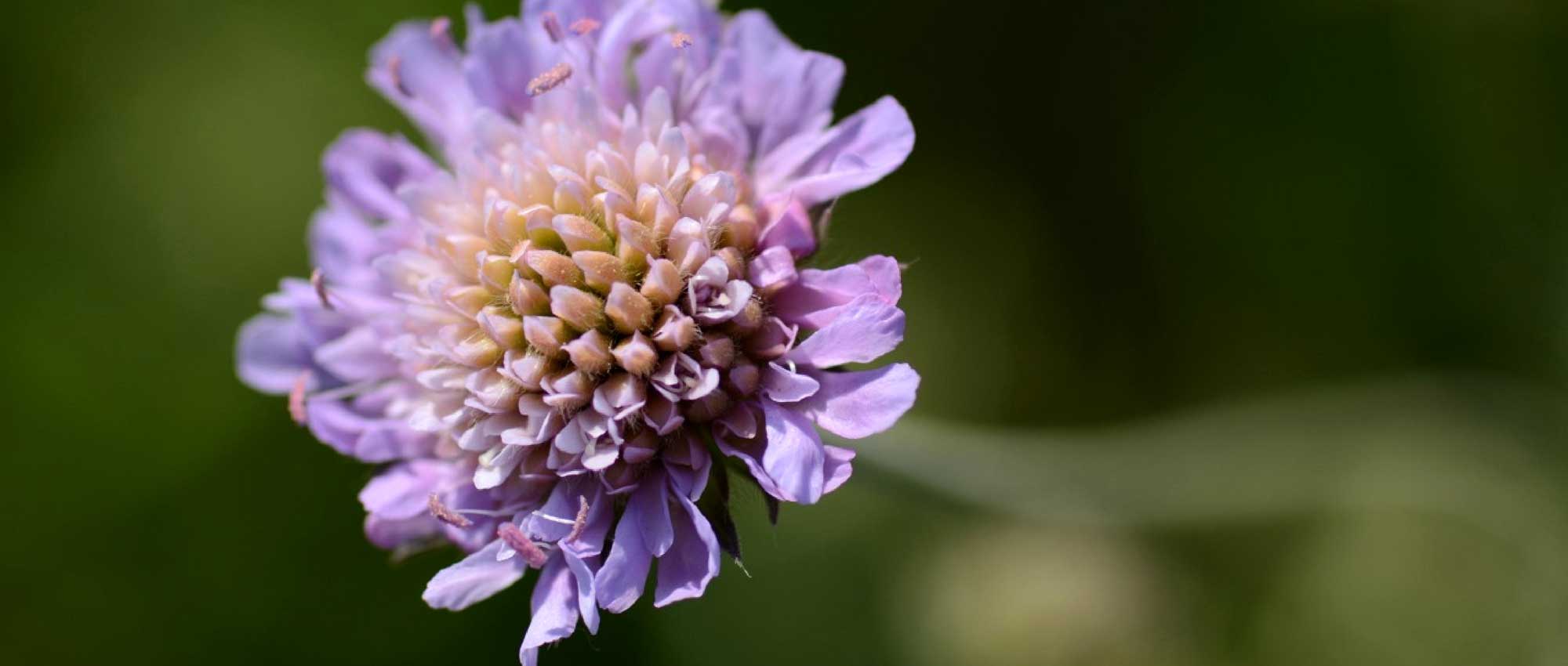
Knautia: planting, growing and care
Contents
Knautia in a nutshell
- Knautia offers a long flowering period, often lasting from June until the first frosts!
- It brings lightness and transparency; it is the perfect perennial for naturalistic gardens!
- Knautia is a robust young plant, very easy to cultivate, drought-resistant, requires little maintenance, and is rarely diseased.
- Its flowers in head-like clusters are often mauve violet or purplish red.
- Its flowering is melliferous, attracting bees!
A word from our Expert
Knautias are often perennial plants that charm us with their long, light and delicate flowering. This lasts from spring or early summer until September – October! The flowers resemble pom-poms borne on very flexible stems. They have a beautiful mauve-purple hue in Knautia arvensis, the Field Scabious, also known as Field Knautia… While they are dark purplish-red in Knautia macedonica, the small Macedonian scabious. Knautia also has elegant foliage, often beautifully dissected.
Knautia is a plant that enjoys sunlight and well-drained substrates. With its very wild appearance, it is ideal for naturalistic gardens but can also fit into a dry garden, scree garden or Mediterranean garden. It grows quickly and has excellent hardiness. Once well established, it tolerates drought and is rarely diseased. It doesn’t require much maintenance. Moreover, if a few faded flowers are left in place, it can self-seed spontaneously! An easy, robust plant with light and long-lasting flowering, Knautia is therefore a flower to favour in the garden!
Description and Botany
Botanical data
- Latin name Knautia sp.
- Family Caprifoliaceae
- Common name Knautie, Scabious
- Flowering from spring or early summer until September - October
- Height variable, but often between 60 and 80 cm
- Exposure full sun
- Soil type draining, rich, rather calcareous
- Hardiness between -15 and -20 °C
Knautias comprise between 50 and 60 species of herbaceous plants, mostly perennials, although there are also annuals. They are found in temperate regions, across Europe, in the Balkans and the Caucasus, extending to Siberia and North Africa… In gardens, the most common are Knautia arvensis and Knautia macedonica. The latter originates from the Balkans, specifically Macedonia. In the wild in France, one can find 9 different species, including Knautia arvensis. It is mainly found in fields and meadows, as well as on slopes and along roadsides. It grows up to 1,900 m in altitude. As these are plants from temperate regions, knauties have excellent hardiness.
Knautia was named in honour of Christoph Knaut (1638 – 1694), a German physician and botanist. The species name, arvensis, means “of the fields” (from the Latin arvum: field), referring to its habitat. The species name macedonica means “from Macedonia”.
This plant is commonly called Knautia or Scabious, although the latter name more specifically refers to the genus Scabiosa, with which it is often confused. In fact, Knautia macedonica is sometimes found under the scientific name Scabiosa rumelica (synonym). In French, Knautia arvensis is often called Field Scabious, but sometimes also Widow’s Flower or Donkey’s Ear.
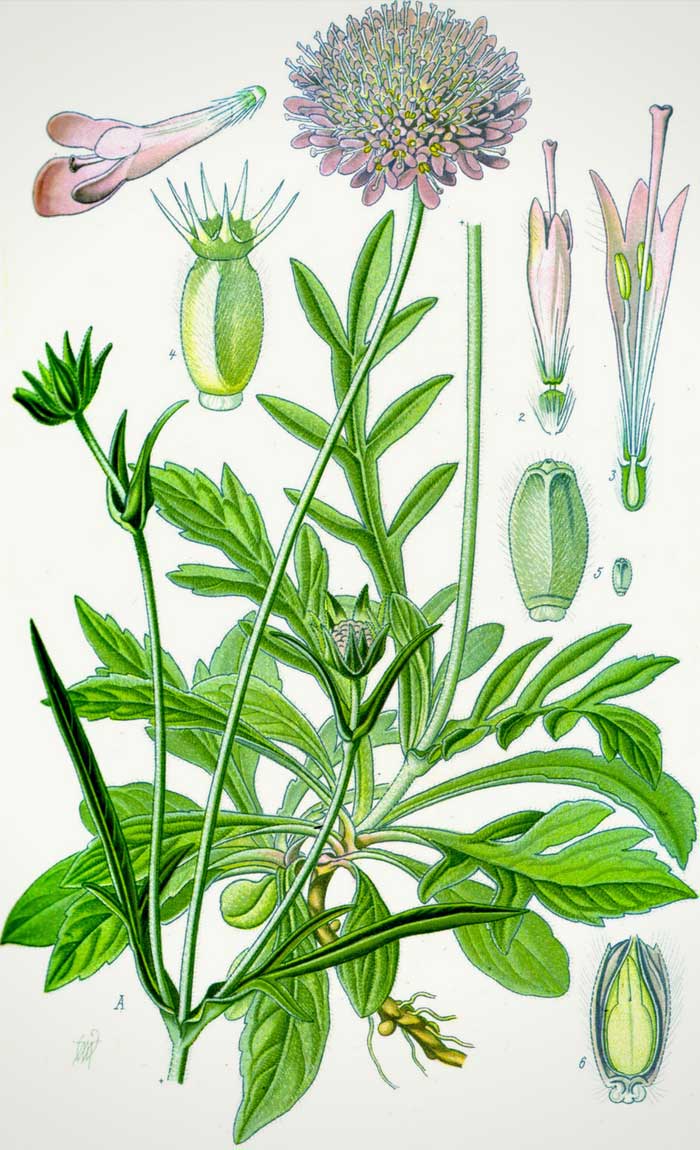
Knautia arvensis: botanical illustration
Knautia belongs to the Caprifoliaceae family (over 800 species). It was previously classified in the Dipsacaceae family, which has since been invalidated and included in the Caprifoliaceae family. This is the family of honeysuckle, which includes several other ornamental plants, such as Abelia, Centranthus, Dipsacus (teasel), Weigelia, or valerian… And of course, Scabiosa, the true scabious. The knautie closely resembles it, leading to real confusion. Similarly, their flowers are very similar to those of Cephalaria, as well as Succisa (Succisa pratensis), two other plants from the same family!
Knautias are fast-growing plants. They often measure between 60 and 80 cm in height, but Knautia arvensis can reach up to 1.5 m tall! There are also compact varieties, more suited for borders, pot planting, or more structured beds. For instance, ‘Thunder and Lightning’ does not exceed 50 cm in height. Knauties have a rather spreading habit, forming large tufts of very thin, slender stems. These are very flexible and somewhat branched. They are not dense plants; on the contrary, they are very “transparent”, allowing light to pass through!
Knautias have the advantage of flowering for a long time and continuously, from spring or early summer until the first frosts! They often provide at least four months of flowers. The flowering of Knautia arvensis begins in May; that of Knautia macedonica arrives a little later, from July to August. Their flowering continues until September – October.
What is perceived as a flower is actually a cluster of small flowers densely grouped together, inserted on a short stem. This collection of flowers is called a head, as seen in daisies or dandelions! In knautias, it takes a rounded, dome-shaped form, measuring between 2 and 4 cm in diameter. The heads are surrounded by bracts that form an involucre.
The corolla is tubular and opens into four lobes, corresponding to four fused petals… This allows for differentiation between knauties and scabious, whose florets have five lobes! The flowers placed on the outside, at the periphery, have much more developed lobes and a radiant appearance. The lobes have an irregular shape, and they are not all the same size! The stamens are very visible, protruding from the tube of the corolla like little threads, giving the flower a somewhat silkier appearance. In the case of the knautia ‘Mars Midget’, the stamens are quite decorative: their white hue stands out strongly against the darker purple head!
The flower stems are long and quite flexible; they bear the rounded heads at their tips. Thus, knautias are well-suited for making bouquets! In a vase, the flowers last between a week and 10 days.
The flowers can have a soft, violet-mauve hue, as seen in Knautia arvensis… But they can also be dark purple, with a rather intense and unusual shade, as seen in Knautia macedonica, ideal for adding depth and contrast to flower beds! The variety ‘Melton Pastels’ produces flowers in various shades, ranging from pinkish white to soft red, sometimes with violet flowers. Within a single plant, the flowers offer a beautiful harmony of pastel pink shades.
Depending on the different species and varieties, knautia flowers reveal a stunning array of shades, from very light violet-mauve, almost white, to dark red, passing through pink or purple tones… The nuances are quite subtle!

The flowers of knauties! Knautia arvensis (photo Björn S.), Knautia macedonica (photo Epibase), and Knautia ‘Thunder and Lightning’
The knautia is a very good nectar plant, its flowers are appreciated by bees.
The leaves are quite elongated, oblong to lanceolate, and are pubescent. They often have a different appearance depending on whether they are basal leaves, in a rosette, or cauline leaves (= located on the stem). Generally, those inserted at the base of the plant are rather entire, simple, while those placed on the stems tend to be divided into fairly thin segments. The foliage is then beautifully cut, with a terminal lobe larger than the others. On a single knautia plant, the leaves thus take on variable shapes!
The leaves of knautias are opposite, arranged in pairs on the stems. They are generally few in number on the stems, giving the plant a lot of transparency and lightness!
Although the knautia usually has green leaves, there is a surprising variety with variegated foliage: Knautia macedonica ‘Thunder and lightning’ has green leaves edged in cream white! It brings a lot of brightness to the flower beds and is ideal for playing with contrasts!

A divided leaf of Knautia arvensis / The variegated foliage of Knautia macedonica ‘Thunder and Lightning’
Knautias have a taproot that penetrates deeply into the soil and anchors them securely. This allows them to seek water far into the ground, making them quite drought-resistant. However, this makes transplantation difficult.
When the flowers have faded, the knautia produces achenes (dry fruits that do not open at maturity). They are surrounded by the calyx and have fine teeth at their tips. The seedheads are quite decorative! It often happens that the knautia self-seeds in the garden… But it does not become invasive! You can collect and replant the young seedlings from these spontaneous sowings.

The seedheads of knauties! Knautia arvensis (photo Matt Lavin) and Knautia macedonica ‘Melton Pastels’
Read also
Scabiosa: sowing, planting and growingThe main varieties of knautie
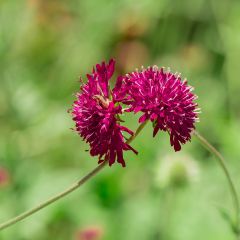
Knautia macedonica
- Flowering time July to October
- Height at maturity 70 cm
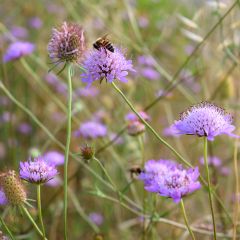
Knautia arvensis
- Flowering time July to October
- Height at maturity 80 cm
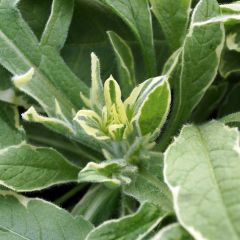
Knautia macedonica Thunder and Lightning
- Flowering time August to October
- Height at maturity 45 cm
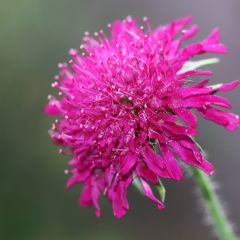
Knautia macedonica Mars Midget
- Flowering time August to October
- Height at maturity 70 cm
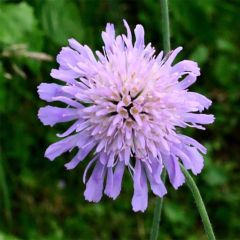
Knautia longifolia
- Flowering time July to October
- Height at maturity 60 cm
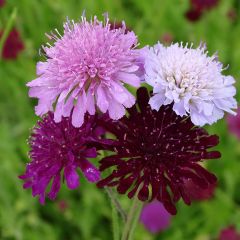
Knautia macedonica Melton Pastels - Macedonian scabious
- Flowering time July to November
- Height at maturity 70 cm
Discover other Knautia
View all →Available in 2 sizes
Available in 1 sizes
Available in 1 sizes
Available in 1 sizes
Available in 1 sizes
Available in 1 sizes
Young plantation
Where to plant?
The ideal is to install the knautia in full sun, although it can tolerate some shade during the hottest hours of the afternoon. You can afford to place it in partial shade if you live in the south of France… But north of the Loire, it’s better to plant it in full sun! Flowering will be more generous if the plant receives at least 6 to 8 hours of direct sunlight.
It is important that the substrate is well-draining. The knautia does not like soils that retain water: if your land is heavy or clayey, you will need to improve the drainage! It can be installed in rocky or stony soils…
Knautias also appreciate substrates rich in organic matter. You can add some compost at the time of planting. They have a preference for slightly calcareous soils.
The knautia does not appreciate root competition. Maintain a good planting distance, avoiding placing it too close to other plants that might suffocate it.
It can be placed in summer beds, at the edge, or even in pots for the more compact varieties. It integrates well into Mediterranean gardens and dry gardens, and can also find its place in a rockery. Finally, as it is a robust plant that requires little attention, you can install it in a fairly wild and natural area of the garden, where you will rarely intervene.
When to plant?
It is possible to plant the knautie in spring, around April, or in autumn, in September – October. Avoid intervening during periods of severe frost.
How to plant?
It is preferable not to install the knautia alone, but rather in groups of at least 5 young plants. In a naturalistic garden or a flowering meadow, feel free to plant them in masses. We recommend maintaining a distance of at least 40 cm between the plants.
- Start by placing the root ball in a basin filled with water.
- While it is soaking, dig a planting hole two to three times the size of the root ball. Add some gravel if necessary to improve drainage.
- Remove the root ball from its pot and place it in the planting hole. The collar of the plant should be level with the soil or slightly raised to prevent water from pooling.
- Fill in around it with soil and firm it down.
- Water generously.
We recommend applying a mulch to keep the soil cool and to slow down the growth of weeds.
You can also plant it in a large pot or container, at the bottom of which you will have placed a layer of gravel or broken pot shards to allow for good drainage.
Also, check out our video tips on planting perennials:
Care
A great naturalistic and wildflower garden plant, Knautia is a robust flower that requires little attention! You can leave it in an area of the garden where you rarely intervene.
It is preferable to continue watering in the year of planting, while Knautia establishes itself and develops its root system. Afterwards, its taproot will enable it to withstand drought well. On the contrary, excess moisture should be avoided.
We advise you to cut the flowers when they are faded, both for aesthetic reasons and to encourage the plant to produce new flowers. However, you can leave a few in place so that Knautia can self-seed spontaneously! Similarly, if you choose to leave all the faded flowers, it’s not a problem, as the seed heads are also decorative!
It is always best to install a layer of mulch to limit the growth of weeds and keep the soil cool for longer.
You can perform light pruning from time to time on the stems that grow outward, or on Knautias that become really large. Likewise, to maintain a harmonious shape, you can install discreet supports to hold up the taller varieties.
Feel free to also harvest the flowers to create bouquets!
Knautia is rarely affected by diseases or pests! It is sometimes attacked by aphids. These small insects settle on the plant and pierce the tissues to extract the sap. The plant becomes weakened, its leaves may become distorted, and sooty mould may sometimes appear. If you notice their presence, you can treat it by spraying with black soap.
Multiplication
To multiply knautias, we recommend sowing, which is quite easy to do. They can also be propagated by cuttings.
Sowing
You can collect seeds from your knautia plants (this means you have left some faded flowers in place), or buy them directly. You can also allow the knautie to self-seed spontaneously, without intervention… Then dig up and transplant the young plants!
The best time to sow knautias is early spring, in March or April. We suggest cold stratifying the seeds before sowing, by placing them in a plastic bag mixed with vermiculite or damp sand, which you will keep in the fridge for at least three weeks.
- Prepare a seed tray or pot. Fill it with special seed compost and gently firm it down.
- Scatter the seeds on the surface.
- Lightly cover with a thin layer of sieved compost.
- Water gently.
- Place the pot in a sheltered spot with plenty of light. The temperature should be between 20 and 24 °C.
Seeds generally take two to three weeks to germinate.
You can also sow directly in place in autumn.
Propagation by Cuttings
Knautia can also be multiplied by taking basal stem cuttings in spring (April – May). Unlike sowing, this technique has the advantage of ensuring young plants identical to the original variety (which is interesting if you are growing ‘Thunder and Lightning’ or ‘Mars Midget’, a bit less so if they are botanical species).
- Prepare a pot with compost.
- Take a segment of stem from the base of the plant, bearing a few leaves. Cut cleanly, just below a node (the point where leaves attach to the stem). If there are leaves at the base of the stem, remove them, leaving only a few at the top.
- You can dip the base of the stem in rooting hormone.
- Then transplant it into the substrate.
- Firm the compost around it well.
- Cover the pot with a film or plastic bottle to maintain humidity. Ventilate occasionally to prevent the development of fungi or diseases.
Keep the substrate moist, but not overly wet, by watering regularly.
→ Learn more about the multiplication of Knautias in our tutorial!
Association
Knautias are ideal for naturalistic, country-style gardens! You can scatter them in a wild meadow, alongside field flowers. Pair them with flax, poppies, and cornflowers, grasses, meadow sage (Salvia pratensis), and thistles. Place them alongside many melliferous plants to promote biodiversity! Create a garden that is welcoming to bees, bumblebees, and butterflies. Knautia arvensis pairs well with the habit and mauve hue of Verbena from Buenos Aires, as well as the graphic flowering of Hastate Verbena (Verbena hastata)!
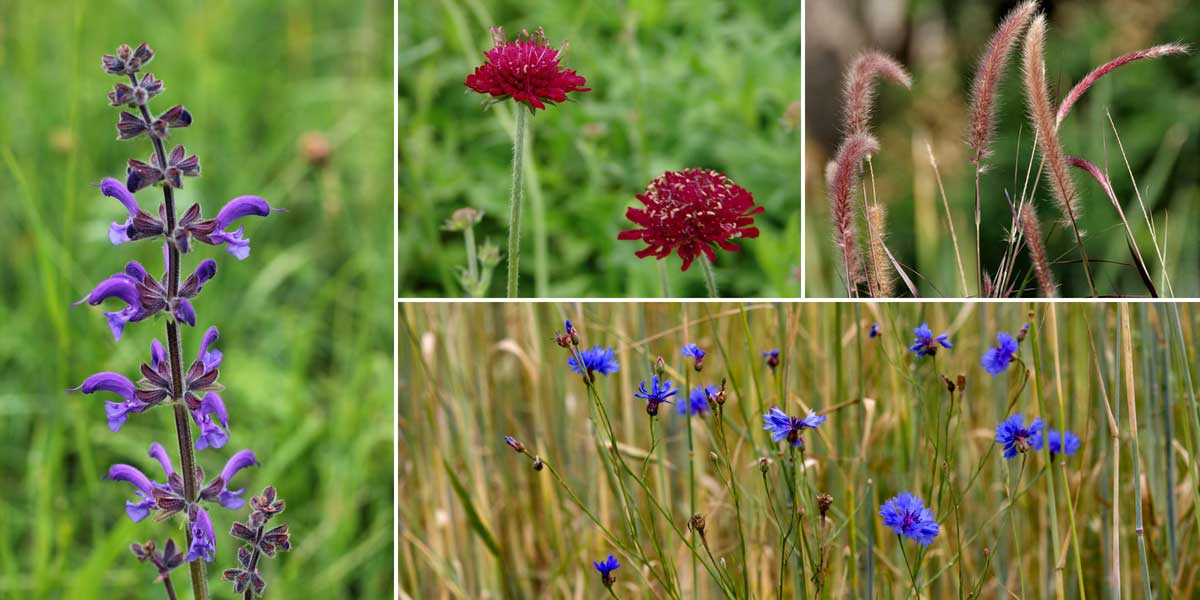
Knautias are ideal for creating a naturalistic garden! Meadow sage (Salvia pratensis – photo Lubaer), Knautia macedonica, Pennisetum setaceum, and Cornflower (Centaurea cyanus – photo Tauri Pärna)
Knautia easily fits into a dry garden or Mediterranean garden, as it enjoys warm, well-drained, even rocky exposures. You can pair it with the yellow flowers of Phlomis fruticosa, with lavenders, sage, santolines, and yarrow… Don’t hesitate to create a rockery, a raised bed in full sun, where you can install large stones and drought-resistant plants. Place Knautia alongside helianthemums, cistus, and euphorbias.
It will also find its place in a colourful mixed border. Pair it with bellflowers (Campanula lactiflora or persicifolia…), echinaceas (Echinacea purpurea), yarrow, and the romantic flowering of roses. Add tall white flowering epilobiums, and enjoy the long flower spikes of Veronicastrum!
Knautia can be used to create a very graphic effect. It will fit well in a modern garden with clean shapes, featuring straight lines and some curves drawn by trimmed plants (boxwood, yews…). Add bamboo and horsetails for verticality, and create contrast with free and airy forms: Briza media, Stipa pennata, Buenos Aires verbenas, Echinops, ornamental Alliums… Preferably choose Knautia macedonica and bring in understated and contrasting blooms, from white to black.
Don’t hesitate to play with colours: for a very soft and delicate garden, pair Knautia arvensis with Musk Mallow, Verbena hastata, with some agastaches, as well as a few old roses… Enjoy the blue, starry flowers of Wild Chicory, Cichorium intybus. Conversely, you can create contrasts by pairing Knautia macedonica with other very dark and deep blooms (Sanguisorba ‘Tanna’, Centaurea ‘Black Sprite’…), and with white flowers (Achillea ptarmica ‘Perry’s White’, Cosmos bipinnatus…). Knautia is also ideal for accompanying plants with grey or silver foliage (Stachys byzantina, santoline…)!
Did you know?
- A medicinal plant
Field knautia, Knautia arvensis, is a purifying, astringent, and diuretic plant that can be used in infusion. It is also effective against coughs and can be used to treat wounds and injuries. The young leaves and flowers are edible and can be used, for example, to decorate salads.
Useful resources
- Discover our range of Knautia!
- Discover our 7 ideas for pairing Knautia
- If you love Knautias, also discover Scabious, very similar plants!
- Subscribe!
- Contents
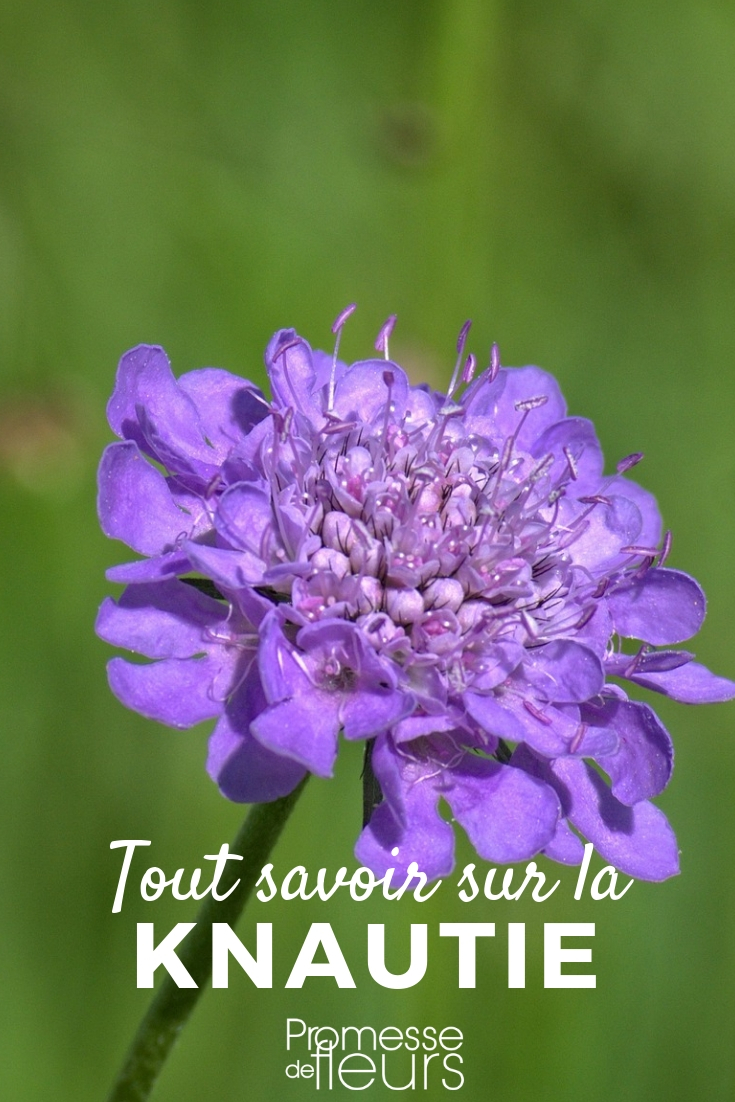


































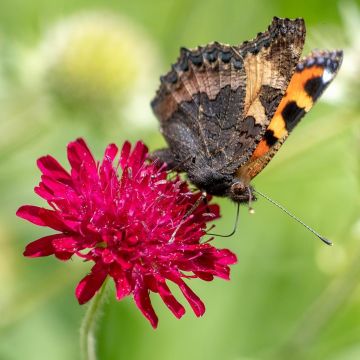


Comments